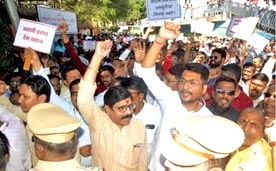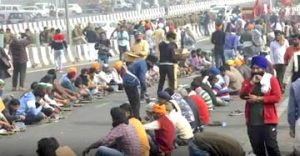Garment Workers: Defeat Capitalism and Its Divisions with Communist Organization here ♦ Letters here ♦ Report from India: ICWP Grows Amid Class Struggles here ♦

Mumbai, India, January 4: Electrical power workers strike against privatization of the state-run company
Garment Workers: Defeat Capitalism and Its Divisions with Communist Organization
BENGALURU (India), December 2022— “Yes, comrade, it is true. We have no facility to survive,” said Poonam. “Why? Because the capitalists are taking money from us. They live in luxury, but we live in slums.
“But that is not the only problem,” she continued. “They make profit from our work and then they use it to oppress us more. How? Because they use modern machines to lay off workers. This is capitalism, the only way the workers can get what they deserve is by getting rid of the capitalist system and build communism.
“Communism is a society without money, the bosses, the banks,” Poonam explained. “Only when we have communism, we share everything among the working class because nobody is going to profit. So we have to organize the working class with our Red Flag, recruit more workers, bring them to meetings like these. We don’t have to feel hopeless. We have the world to win! Join ICWP!”
Alisha spoke up. “See, comrade, we are meeting today because the problems we face are real. But if you read Red Flag, you will see that our problems are not unique. We have unemployment, comrades in El Salvador have unemployment. We all suffer from the lack of healthcare. Capitalists make profit, it does not matter where.
“We have different languages, different cultures, different religions,” she said, “but in the end, we as workers face the same oppressive bosses. And so we need communism that will eliminate all the backward aspects of our society. Dalits, Muslims, and the rest of the working class will live together, eat together, and share lives as a working class. That is the real meaning of communism.
“Without a communist outlook,” Alisha concluded, “they will divide and conquer us. But the other side is the working-class unity. So let us fight to achieve one class in a fight to smash the bosses.”
Rajashree declared, “Comrades, I want to send our greetings to the comrades all over the world. The example of our comrade Manju, who came to look for a job in Bengaluru and is harassed by sexist bosses, this cannot continue to exist. We need to fight this sexist outlook. It only makes us divided and makes the bosses powerful.”
“We feel your pain, comrade Manju,” said Mehbooba. “The next time you have a problem, call me and I will call others in the neighborhood. We will confront this sexist pig. I always go to my neighbors with a leaflet of ICWP and communism. These neighbors will protect you. They know what real communism is.”
Letters:
Questions about India’s Caste System
It has been exciting and upbuilding to read articles on the growth of our party in India. These articles describe the protests, the sharing of work, and development of new groups.
I recently read a magazine article by a well-known Indian American woman. She reviewed a book, The Trauma of Caste, by Thenmozhi Soundararajan. The reviewer mentions that her family is from the highest-level caste, one that is only 5% of the population but owns almost half of the whole country’s wealth. This writer admits that she benefits from belonging to this “upper-level” group, even though her parents say they don’t believe that some people are superior and others inferior.
I am wondering if this system of “castes” has affected the party’s work in India? Are there any party members who are from a privileged group but want to end this very unjust system?
The caste system is based on religious beliefs and is very ancient and accepted. The writer mentions that even in the United States and other places with large groups of Indian emigrants, the caste system comes along with them. This is disturbing; but of course, it would be one of the things that a new and better system (communism) would end!
—Comrade in the USA
Red Flag responds: Caste, Colonialism, and Capitalism
Understanding caste in India requires us to understand the history of the working class in South Asia under British colonial rule.
In 1857, Hindu and Muslim rulers united, attempting to overthrow British rule. This mutiny, known as the Sepoy Rebellions, was unsuccessful. The triumphant but shaken British rulers decided to divide Hindu and Muslim rulers as never before. They used religious divisions to occupy India for the sole purpose of creating agricultural products, minerals, and coal to support capitalist production in Britain. Direct British rule replaced the East India Company.
British colonial administrators learned from Ireland, where divisions between Protestants and Catholics had allowed them to subjugate Ireland for British capitalism. In India also, religion became the foundation of capitalism’s divide-and-conquer policy.
Hinduism’s ancient caste system embodied a social division of labor. Brahmins, the highest caste, performed religious duties, and had the privilege of reading texts. The Kshatriyas were warriors and soldiers. The Baniyas were traders. And Shudras did manual work.
The caste system was hereditary. It was brutally enforced with religious justification, with the Brahmins playing a significant role.
After 1857, the British realized that India, a vast country, needed locals who would function as junior colonial administrators. For this they trained some Brahmins in the English education system.
Capitalist agricultural production of jute, indigo, cotton, and rice broke the feudal system based on the hereditary caste system. It slowly created a class of proletarian wage slaves. This wage system required a divided working class, and casteism became a capitalist tool. The Shudras, given the most difficult manual work, became modern Dalits. The Brahmins were supervisors, the Kshatriyas were recruited into the army, and the Baniyas were traders and accountants. That is, the caste system is used to ideologically justify capitalism.
Our party struggles to eradicate the caste system by uniting workers as a revolutionary class that will end wage slavery with the communist revolution. India’s capitalist rulers still use caste and religion to divide the working class. We struggle with the masses by spreading Red Flag and recruiting young Dalit, Muslim, and Hindu workers to one communist party.
We will write more for Red Flag about the communist fight against caste and religious divisions.
Report from India: ICWP Grows Amid Class Struggles
The following is an edited narration from a short video report produced by comrades in India for the December ICWP International Conference in El Salvador. The video is available here
Since 2014, the fascist Modi government has intensified attacks on the working class in India. Dalits, Muslims, other minorities have borne the brunt of these fascist attacks on workers’ daily lives. However, it is an attack on the entire working class. By isolating Dalits and Muslim workers as “the enemy,” the capitalists are deceiving the workers. It is the working class who suffers.
Our party ICWP in Delhi, India was formed during the time of increasing fascist attacks. Every fascist attack in Delhi has led to a massive counterattack by the working class. The violent protests at Jawaharlal Nehru University (JNU) and Delhi University gave us the opportunity to organize some workers and students with Red Flag.
Delhi has become a center of massive rebellion by the working class, from JNU to the Shaheen Bagh neighborhood. In the face of attacks on the Aligarh Muslim University and systematic pogroms of the Muslim workers, the masses have heroically countered the narratives of the fascist forces.
Each of these struggles involved more and more of the working class joining ICWP and massively spreading Red Flag. From the despicable gang rape and murder of a young Dalit woman in Hathras (which cops covered up by burning her body), to the horrors of Covid, our members have organized the masses. ICWP comrades have protested the Bulldozer drives that the Modi government is using to destroy Muslim homes.
From the rebellious students and the railway agitation in Bihar, the Ukraine crisis where Indian students came back to Delhi, ICWP members were there to give the communist alternative and we recruited more students.
We participated in the langars (mass collective food distributions) during the Covid crisis and massive farmers demonstrations for months. We have been part of the working-class movement in opposition to the racist anti-immigrant laws (NCR, CAA) to cement our ties with the workers.

NEW DELHI (INDIA), December 2020—Langars serving farmers during mass protest.
We are facing fascist conditions when governments legally kidnap people under the 2019 Unlawful Activities (Prevention) Amendment Act for many years without legal charges.
Masses of workers have organized in the garment neighborhoods of Bengaluru against oppressive conditions. Millions of other workers, including ASHA (community health workers) in India’s so-called Silicon Valley have been in the forefront of the protest movements.
In Bengaluru we have been able to establish a small number of workers of ICWP. They work in garment factories that produce for H&M, Tommy Hilfiger, Target, Zara, Benetton, Mango, SportsZone, and more. We distribute Red Flags in the factories to some friends, and to others in our neighborhoods.
We have been able to reach out to many other workers like the ASHA workers and some workers in Colombo, Sri Lanka. We met the women in the garment industry of Sri Lanka during the massive crisis that burnt the palaces of the President there.
The video ends with the words of the women garment comrades while the Internationale plays in Bengali and Hindi.


